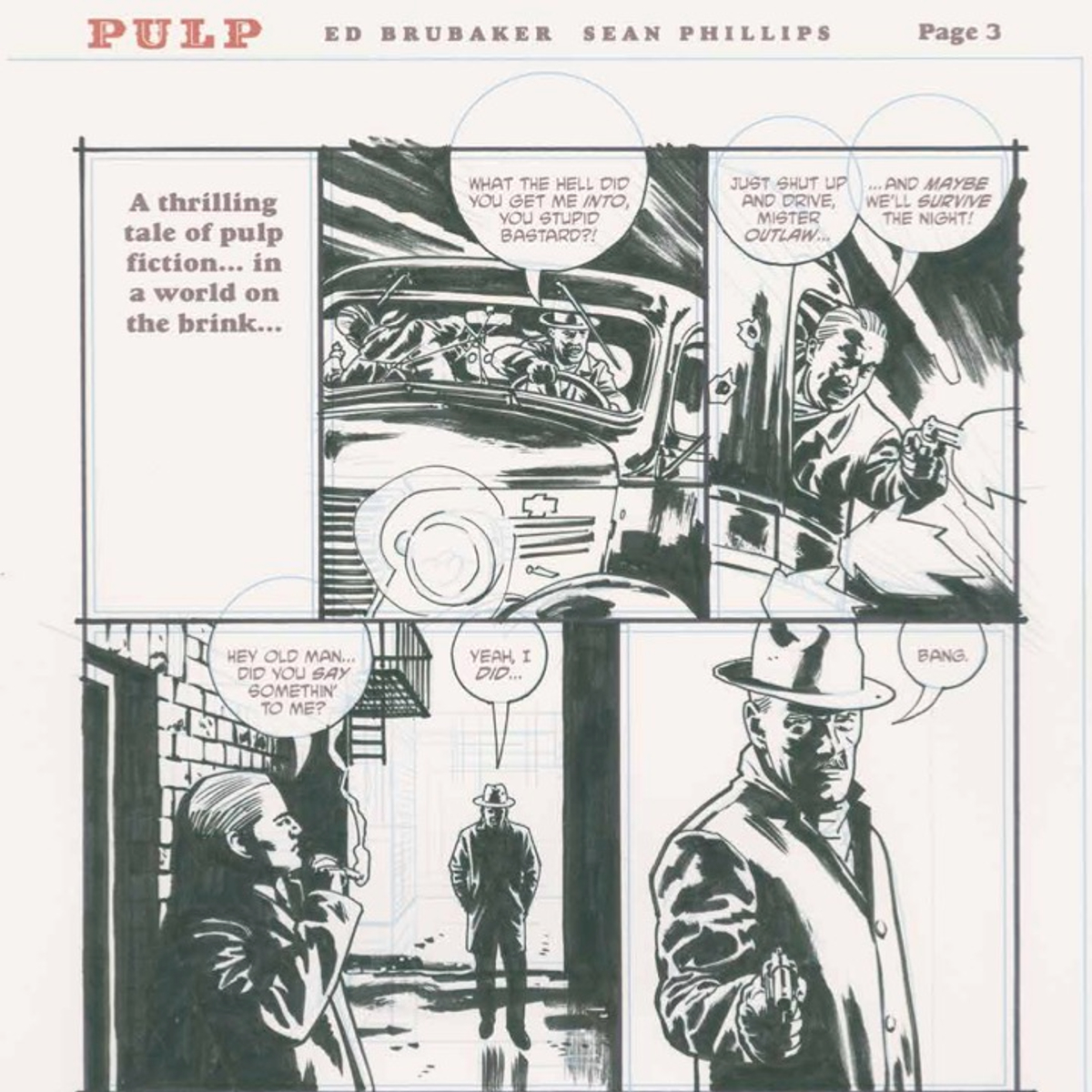Sean Phillps and Ed Brubaker. Man. They’re one of the great long-running creative duos in western comics. Sleeper is a really neat “superhero for grown audiences” book, a shining light from one of the most interesting periods in Wildstorm’s history. Criminal has seen the duo wield comics’ tremendous formal flexibility to explore the noir they love from a variety of angles. And Reckless, their ongoing series of graphic novels (done in collaboration with Phillips’ son Jacob)? I love Reckless. So, when Pulp: The Process Edition—a deep dive into the making of Phillips, Phillips, and Brubaker’s 2020 western noir Pulp–was announced? I was excited.
And I was right to be excited. As someone who adores this team’s work, Pulp: The Process Edition is a downright delightful dive into how they approach their craft as individuals and as a team. As someone with a longtime interest in the craft and art of comics, Pulp: The Process Edition goes into welcome detail about the flow of Phillips and Brubaker’s craft generally and the crafting of Pulp from concept to completion specifically.

The Process Edition‘s presentation is very fine, particularly its organization. After an introduction from Brubaker, the book divides itself up into sections, each devoted to a different part of the craft. Brubaker discusses his writing process. He begins by mulling, in Pulp‘s case about westerns, his near-drowning, and what his wife would have had to deal with had he died. Once he’s reached the point where he knows enough to “put it down on paper,” Brubaker begins notebooking—which he describes as “somewhere between an outline and a place to ask myself questions or try out ideas I may not actually use.” It’s a process that varies from book to book for him.
Once he’s completed notebooking, Brubaker moves into typed scripting (including notes on his tools, tools I plan to acquire for my own workspace—thanks Mr. Brubaker). It is here that Brubaker says “…a lot of the creative process takes place in the scripting. I prefer it that way. I know what the story is about, and what the big goalposts are, but I have room to roam as I write.”
Phillips discusses the design and creation of Pulp‘s cover. Like his longtime creative partner, he’s an engaging voice, laying out not only his practical hows of illustration and painting for comics but his whys as well. One technique I found striking: While Phillips used the comics-specific software Clip Studio Paint to draw Pulp‘s final cover, he “included layers of scans of real paper for textures.” On this, Phillips says “I like to add those to most of my digital paintings to stop them from looking too clinical.”
From there, The Process Edition uses Pulp‘s “trailer”—the short comics Phillips and Brubaker make to advertise their longer form work to set the general format for their exploration of Pulp as a whole—Brubaker’s script, followed by Phillips’ pencils, followed by the finalized comic. In between the trailer and the full book, Phillips breaks down his thumbnailing process, starting with going through the scripts until he knows how they will flow in page form, and then sketching the thumbnails in a notebook. He says, “…drawing very crudely, I indicate what will be in each panel just for rough placement and composition. I’m not interested in making a nice drawing yet, the thumbnails are just for working out how to tell the story.”

From there, The Process Edition moves into its core section. Brubaker’s scripts are followed by Phillips’ pencils. This highlights both men’s individual skills, as well as why their collaborations work so well. They bring out each other’s strengths, and after years of working together, they have gotten good at doing so.

Upon the conclusion of the script/pencil presentation, Phillips discusses his ink work—including his search for “that elusive Magic Brush to make my drawings look more like my favourite artists.” Colorist Jacob Phillips takes over to detail the coloring process. He says, “Whenever I approach anything like this within any of the stories I color or draw I like to make it instantly apparent to the reader exactly where/when they are in the story.” In Pulp‘s case, this meant deploying not only two different palettes for its two different time periods but deploying them in different ways. For protagonist Max’s flashbacks to his days as the gunslinging Red Rock Kid, Phillips turned to the texture of paint rollers. For the present-day 1939 sequences, he deployed techniques closer to those he has used on Criminal and Reckless.
Pulp: The Process Edition concludes with a complete presentation of the original comic. It’s a darn good book on its own, and placing it at the end of The Process Edition is a wise move—it offers an opportunity to trace how the individual pieces of craft showcased earlier in the book become the final comic, and to appreciate just how damn well the creative team work together.
As a longtime fan of Phillips and Brubaker’s work, Pulp: The Process Edition is a worthy celebration of their collaboration. As a comics craft wonk, it is a treat to dig into, thanks to its strong presentation and the thoughtful guidance Phillips and Brubaker offer. It’s a book for a very specific audience to be sure (if someone who likes westerns and noirs wanted to try out comics, I’d give them the standalone Pulp as opposed to The Process Edition), and it is wonderful for that.
Join the AIPT Patreon
Want to take our relationship to the next level? Become a patron today to gain access to exclusive perks, such as:
- ❌ Remove all ads on the website
- 💬 Join our Discord community, where we chat about the latest news and releases from everything we cover on AIPT
- 📗 Access to our monthly book club
- 📦 Get a physical trade paperback shipped to you every month
- 💥 And more!














You must be logged in to post a comment.